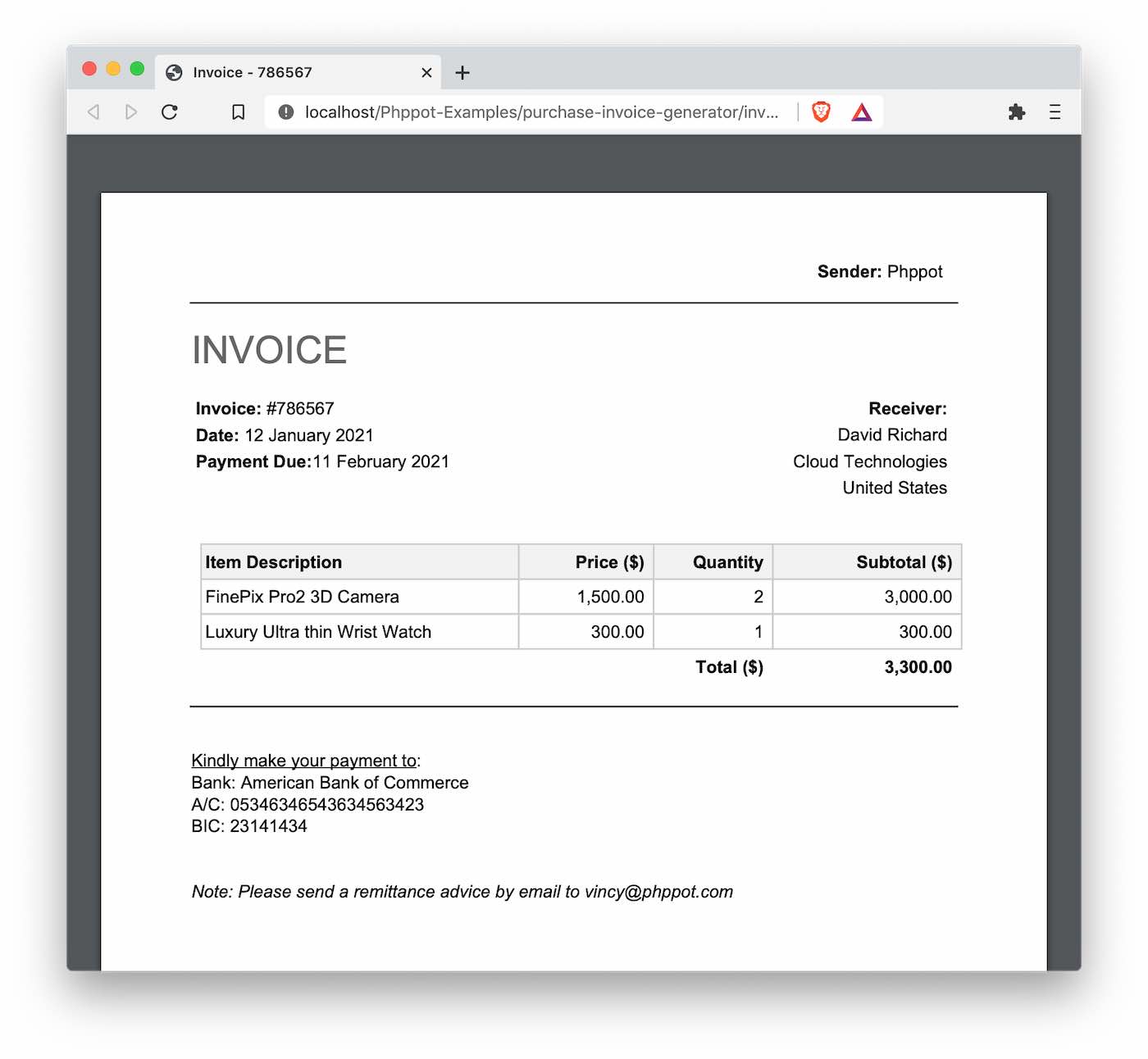use GoogleCloudBillingV1CloudBillingClient;
use GoogleApiCoreApiException;
/**
* Gets all the invoices present in given project
*
* @param string $projectId Your Cloud Project ID
*/
function get_invoices(string $projectId): void
{
$cloudBilling = new CloudBillingClient();
$pageSize = 10;
try {
$invoices = $cloudBilling->listInvoices($projectId, [
'pageSize' => $pageSize,
]);
} catch (ApiException $e) {
if ($e->getStatus() === 'NOT_FOUND') {
printf('No invoices found for %s' . PHP_EOL, $projectId);
return;
}
throw $e;
}
if (empty($invoices->iterateAllElements())) {
printf('No invoices found for %s' . PHP_EOL, $projectId);
return;
}
foreach ($invoices->iterateAllElements() as $invoice) {
printf('Got invoice %s' . PHP_EOL, $invoice->getName());
print(str_repeat('=', 20) . PHP_EOL);
printf('Invoice Amount: %s' . PHP_EOL, $invoice->getAmount()->getAmount());
printf('Invoice State: %s' . PHP_EOL, $invoice->getState()->name);
printf('Invoice Issue Date: %s' . PHP_EOL, $invoice->getIssueDate()->getSeconds());
printf('Invoice Due Date: %s' . PHP_EOL, $invoice->getDueDate()->getSeconds());
printf('Invoice URL: %s' . PHP_EOL, $invoice->getInvoiceUrl());
if ($invoice->hasPurchaseOrderNumber()) {
printf('Purchase Order Number: %s' . PHP_EOL, $invoice->getPurchaseOrderNumber());
}
if ($invoice->hasDescription()) {
printf('Invoice Description: %s' . PHP_EOL, $invoice->getDescription());
}
if ($invoice->hasDisplayName()) {
printf('Invoice Display Name: %s' . PHP_EOL, $invoice->getDisplayName());
}
if (count($invoice->getCustomAttributes()) > 0) {
printf('Custom Attributes: %s' . PHP_EOL, print_r($invoice->getCustomAttributes(), true));
}
print(PHP_EOL);
}
}
```# **Invoice Generator Php Github**
## Executive Summary
This article provides a comprehensive guide to leveraging PHP and GitHub for invoice generation. It explores the benefits of using PHP, explains how to set up a GitHub repository, and offers a step-by-step tutorial on creating an invoice generator using PHP. Additionally, the article discusses advanced techniques for customizing and deploying the invoice generator.
## Introduction
Invoices are essential documents for businesses to track payments and manage their finances. Creating invoices can be a time-consuming task, but using PHP and GitHub can streamline the process. PHP is a powerful scripting language that is well-suited for web development, while GitHub is a popular platform for hosting and collaborating on code projects.
## FAQs
1. **Can I create invoices using PHP without GitHub?**
Yes, it is possible to create invoices using PHP without GitHub, but using GitHub provides several advantages, including version control, collaboration, and easy deployment.
2. **What are the benefits of using PHP for invoice generation?**
PHP is a flexible language that offers many benefits for invoice generation, including:
* **Cross-platform compatibility** - PHP can run on various operating systems and web servers, making it easy to deploy invoices on different platforms.
* **Database connectivity** - PHP can easily connect to databases, allowing you to retrieve customer and invoice data.
* **Template support** - PHP can generate invoices using templates, which makes it easy to customize the appearance of invoices.
3. **How difficult is it to create an invoice generator using PHP and GitHub?**
The difficulty level depends on your programming skills and experience. However, this article provides a step-by-step tutorial that makes it easy for beginners to create a basic invoice generator.
## Top 5 Subtopics
### **Setting Up a GitHub Repository**
A GitHub repository is a central location to store and manage your code. To set up a repository for your invoice generator, follow these steps:
* Create a GitHub account if you don't already have one.
* Click on the "New" button in the top right corner and select "Repository."
* Enter a name for your repository and a brief description.
* Click on the "Create repository" button.
### **Creating the Invoice Generator Script**
The invoice generator script is the core of your application. It will contain the code to generate the invoice based on the provided data. Here is a basic example of an invoice generator script in PHP:
```php
<?php
// Define the invoice data
$invoice_data = array(
'customer_name' => 'John Doe',
'customer_address' => '123 Main Street',
'customer_city' => 'Anytown',
'customer_state' => 'CA',
'customer_zip' => '12345',
'invoice_date' => '2024-03-08',
'invoice_number' => 'INV-0001',
'line_items' => array(
array(
'description' => 'Product 1',
'quantity' => 10,
'unit_price' => 10.00,
),
array(
'description' => 'Product 2',
'quantity' => 5,
'unit_price' => 15.00,
),
),
);
// Create the invoice object
$invoice = new Invoice($invoice_data);
// Generate the invoice PDF
$invoice->generatePDF();
?>Customizing the Invoice Template

The invoice template controls the appearance of the invoice. You can customize the template to match your branding and preferences. Here are a few important elements to consider:

- Header – The header typically includes your company logo and contact information.
- Body – The body contains the invoice details, such as the customer information, invoice number, and line items.
- Footer – The footer can include payment terms, notes, or additional information.
Deploying the Invoice Generator

Once you have developed and tested your invoice generator, you need to deploy it to a web server. This will allow you to access the invoice generator online and generate invoices. Here are a few popular deployment options:
- Hosting on a web server – You can host your invoice generator on a web server using a hosting provider such as Bluehost or HostGator.
- Using a cloud platform – You can deploy your invoice generator on a cloud platform such as AWS or Google Cloud.
- Using a static site generator – You can use a static site generator such as Hugo or Jekyll to generate static HTML files for your invoice generator.
Integrating with Other Applications
Your invoice generator can be integrated with other applications to automate your invoicing process. Here are a few popular integrations:
- CRM systems – You can integrate your invoice generator with a CRM system to automatically generate invoices for new orders.
- Accounting software – You can integrate your invoice generator with accounting software to automatically record invoices in your accounting system.
- Email marketing platforms – You can integrate your invoice generator with an email marketing platform to automatically send invoices to customers.
Conclusion
Using PHP and GitHub for invoice generation provides several benefits, including efficiency, customization, and scalability. This article has provided a comprehensive guide to creating and deploying an invoice generator using these technologies. By following the steps outlined in this article, you can streamline your invoicing process and improve your financial management.
Keywords
- Invoice Generator
- PHP
- GitHub
- Invoice Automation
- Invoice Customization
